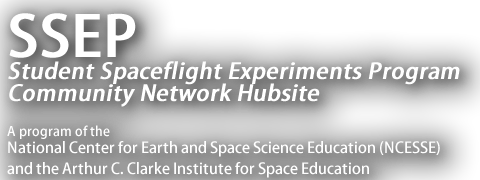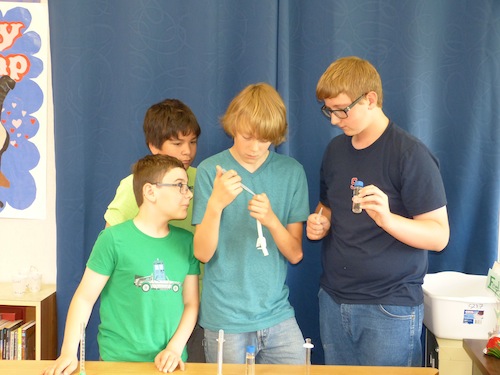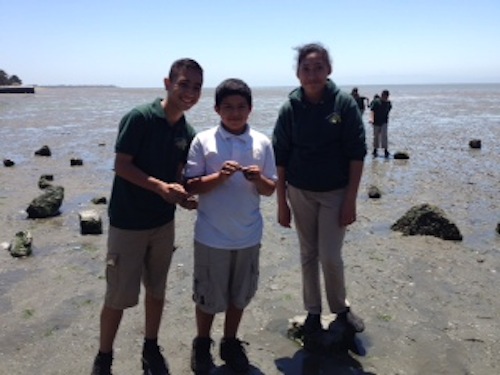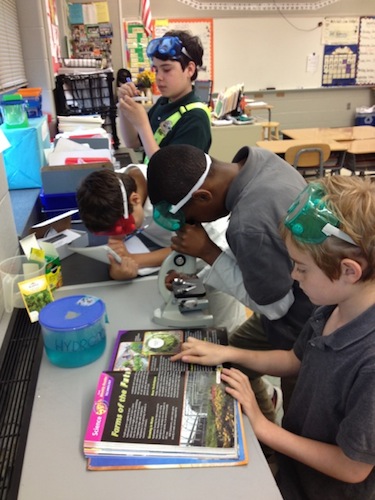The Student Spaceflight Experiments Program is proud to report that there were a total of 1,487 proposals submitted from student teams across the 18 communities participating in Mission 6 to ISS. Of those, 748 proposals were forwarded for review by Step 1 Review Boards in each of the communities. Each Step 1 Review Board selected three finalist proposals, which were submitted to the National SSEP Step 2 Review Board.
On May 20 and 21, 2014, the Step 2 Review Board met at the Smithsonian National Air and Space Museum, reviewed all 54 finalist proposals, and selected one proposal to fly for each community, for a total of 18 flight experiments. By June 20, 2014, the National Center for Earth and Space Science Education and the Arthur C. Clarke Institute for Space Education formally notified each community of their selected flight experiments.
It is noteworthy that the 1,487 proposals received reflected a total of 6,860 grade 5-15 students fully engaged in experiment design.
All 54 finalist experiment teams, along with descriptions of their proposed flight experiments, are provided below. You are also invited to meet the SSEP Step 2 Review Board members for Mission 6 to ISS.
Congratulations to the nearly 7,000 students and their teachers participating in Student Spaceflight Experiments Program Mission 6 to the International Space Station.
1. Kamloops/Thompson, British Columbia, Canada
Jump to Kamloops/Thompson’s Community Profile
SELECTED FOR FLIGHT:
Creating Crystals in Space
Grade 6-7, McGowan Park Elementary, Kamloops/Thompson #73 School District
Co-Principal Investigators: Jordan Brown, Hunter Galbraith, Kieren O’Neil, and Ryan Watson
Co-Investigators: Justin Baker, Kennedy Coates, Daniel Funnell, Kieran Gundel, Dylan Hanson, Grace Heise, Allison Inovas, Jesse Kotani, Kessa Kwiatkowski, Jayden Lajeunesse, Daphne Legault, Blair McLeod, Alysha Muzio, Ellie Parker, Jacob Patton, Daniel Poirier, Jonathan Rinaldi, Kennedy Robidoux, Isaac Sieracki, Jessie Simons, Sylvaine Soth, Tessa Tangas, and Tristan Wyers
Teacher Facilitator: Sharmane Baerg
Proposal Summary:
For our project we want to learn how microgravity affects the growth of crystals. Some of the questions we are wondering about are: How is crystal growth different in microgravity than on Earth? Are the crystals the same shape when they form in microgravity as on Earth? Do the crystals grow to the same size (mass) in the same time? (Do they grow at the same speed?) Do the crystals grow to the same size (volume) in the same time? (Do they grow at the same speed?) Is the concentration of the crystals the same? Where will crystals grow in the tube? Is diffusion of the high concentration to the low concentration solution the same in microgravity and on Earth?
We believe this is important because we can learn more about how fluids act and how crystals (precipitates) form in microgravity. The advantage of understanding if a solid has a different structure in microgravity would be that we could create solids with different properties and be able to make unique materials. It may also help us to move forward with a better understanding of how fluid mixing and crystal formation work in space.
HONORABLE MENTION FINALISTS:
Tooth Decay in Microgravity Environment
Grade 5, Bert Edwards Science and Technology School, Kamloops/Thompson #73 School District
Principal Investigator: Stran Smith
Co-Investigator: Jasmyn Iceton
Collaborators: Jonuh Anderson, Jackson Bartel, Laci Cook, Michael Cotter, Austin Coyle, Maninder Dhillon, Jaidyn Harley, Taleya Hobson, Rylee Hodgson, Darian Jackson, Sam Kjeldsen-Trotter, Audrey Liu-Calver, Ethan McRae, Chloe Macus, Brady Pawlachuk, Katlyn Sangha, Bhavin Serown, Jack Snoddy, Jacob Taylor, Karis Wilson, and Rhyse Wilson
Teacher Facilitator: Steve Bloom
Proposal Summary:
This experiment is designed to see if teeth decay more quickly in microgravity than on Earth. A sterilized pigs tooth will be soaked in a citric acid solution (to simulate orange juice, pH of 3.5) at the International Space Station. Another identical tooth from the same animal will be in a similar solution, for the same time period on Earth. Photographs, masses, and X-rays of both teeth will be taken before they are put into the FMEs, to allow comparison of any colour and structural changes that take place.
When the ISS tooth is returned to Earth, the teeth will be compared for weight, colour, X-ray density, and amount of decay that has taken place.
We think this is important research since tooth health is an important part of the health of our astronauts. If teeth do decay more quickly in space, astronauts may need a different tooth care plan than on Earth. For example, foods that “rot your teeth” may need to be more carefully avoided. Perhaps increased fluoride treatments would be needed as well.
Oil and Water Always Separate. Or Do They?
Grade 5-6, Kay Bingham Elementary, Kamloops/Thompson #73 School District
Co-Principal Investigators: Emma Isaac, Katy Levesque, and Pyper Stocking
Co-Investigators: Mya Dickson, Keauna Kirby-Harris, and Sara Monsees
Collaborators: Nicholas Bandura, Noah Bjarnason, Kara Branchflower, Kobe Carson, Czarina Choy, Seth Christopher, Aiden Filipchuk, Adam Firman, Griffin Ford, Andrew Gemsa, Shyla Huston, Quinten Johnston-Brew, Jordan Laliberte, Xavier Levy, Jayden Lindsay, Charlene Mitchell, Alysia Monsen, Evin Onufreychuk-Lavigne, Gregory Ryles, and Rylen Trent
Teacher Facilitator: Susan Hallett
Proposal Summary:
We have observed that when oil and water are mixed, on Earth, that the oil quickly forms a separate layer on top of the water. We wonder what will happen in zero-g where there is no up or down, top or bottom. If the oil does make a separate layer in zero-g, can we measure how much of the oil separates, compared to a control on Earth?
We plan to mix oil and water, allow time for separation, then use gelatin to ‘gel’ the water and trap any oil that has remained mixed. Oil that has separated from the water will not be trapped in the gel. We will colour the oil with oil-based food colouring so that we can observe if the gel becomes coloured, showing that oil is trapped.
By pouring off the remaining oil when the experiment returns to Earth and measuring its volume compared to the volume in the control on Earth, we can measure any differences.
The assumption that ‘oil and water don’t mix’ affects many things that occur in our daily lives that we take for granted on earth such as: the operation of machinery, resource management, and smooth functioning of the human body. Even small differences in zero-g could add up over time to affect astronauts, their equipment, and their lives.
2. Oakland, California
Jump to Oakland’s Community Profile
SELECTED FOR FLIGHT:
Composting in Microgravity
Grade 6, Urban Promise Academy, Oakland Unified School District
Co-Principal Investigators: Kevin Cruz, Cithlali Hernandez, and Jose Morga
Teacher Facilitator: Julia Lehman, Science Teacher
Proposal Summary:
Our proposed experiment asks the question; if Eisenia fetida (red worms) will compost food waste into soil in microgravity. If they can, it would mean that we could create fertile soil in space that would help plants grow, give out oxygen, and even provide food for astronauts and scientists on the International Space Station [ISS]. We will test this by sending some Eisenia fetida to microgravity and seeing if they can compost the food waste into soil. We will do the same experiment on the Earth so we can compare and contrast the ground results and microgravity results. This is important because this could teach us if Eisenia Fetida can compost food waste into soil for plant seeds. Growing plants in fertile soil could give out food and oxygen to everyone on the ISS and future space travelers. It is also important because this could help the astronauts and scientists on the ISS decrease the amount of space that food waste takes up.
HONORABLE MENTION FINALISTS:
How Will Leopard Frog Eggs Develop in Microgravity
Grade 7, Urban Promise Academy, Oakland Unified School District
Co-Principal Investigators: Odaliz Carmona, Michelle Lara, Stephan Mandigo, and Kelly Munoz
Teacher Facilitator: Alison Ball, 7th Grade Science Teacher
Proposal Summary:
We want to know how Leopard frogs, Rana pipiens, will develop differently in microgravity. Since frogs have existed, gravity has affected them. We are sending Leopard frog eggs to change into tadpoles on the International Space Station (ISS) which has microgravity caused by the ISS orbiting the Earth at 5 miles per second. We would like to observe how the Leopard frogs will change in size, how the lungs develop, and the tadpoles’ cell development. Microgravity could affect the frogs’ DNA which will cause the embryonic polarity to get confused about what goes where, which may cause their legs, hands, and head to form in different areas. When the Leopard frogs come back to Earth we will dissect them to check for symmetry in the organs and to see how the organs developed. Next, we will use blue alcian stain to stain the dead cells to see them under the microscope to compare with the frogs on Earth. The purpose of our experiment is to show how microgravity affects frogs’ development differently from gravity on Earth. If frogs develop differently in microgravity, it could cause a mutation, which could create a new species. If Leopard frogs grow well, then maybe other frogs, amphibians, or humans could reproduce and develop in microgravity.
Does the Capsule of E. Coli Absorb Lead?
Grade 8, Urban Promise Academy, Oakland Unified School District
Principal Investigators: Alejandra Matias, Jocelyn Medina, Yoli Mendez, and Aida Perez
Teacher Facilitator: Leonel Alvarado, Science Teacher
Proposal Summary:
The purpose of our experiment is to prove the effects of lead on E. coli. The results of our experiment are important because if E. coli’s capsule can absorb lead, then there’s a probability that it can reduce lead poisoning. We will grow E. coli using nutrient agar in a Petri dish to feed the bacteria. We will wait 2-3 weeks and record the growth of E. coli and its capsule (slime) production. After that, we will send it to the lab where they will expose E. coli to lead. We will wait a couple of weeks more, but still keep examining it. By the sixth week of this experiment, we plan on measuring the amount of lead that is left. Our hypothesis is that E. coli’s capsule will absorb lead. If this is true, we would like to see the effects of microgravity on this experiment.
3. San Marino, California
Jump to San Marino’s Community Profile
SELECTED FOR FLIGHT:
Effects of Microgravity on Early Musca Domestica Growth
Grade 11, San Marino High School, San Marino Unified School District
Co-Principal Investigators: David Hengky and Nathaniel Rolfe
Teacher Facilitator: Wyeth Collo, Science Department Head Instructor
Proposal Summary:
In our experiment we will investigate the development of Musca domestica (the common housefly) from pupae to adult in microgravity. The housefly, in addition to being a well-known carrier of disease, is also an ideal candidate for studying development as it is both prevalent, and the right size for the confines of the experiment. One to two weeks is the average extent of a house fly’s life cycle but the pupae can remain dormant for upwards of one month, and the adult fly itself can enter a stage of dormancy for close to two days in cold conditions. The experiment will involve the transportation of dormant Musca domestica pupae into microgravity where warmer temperatures will induce the flies to exit dormancy, develop, and eventually hatch from the pupae. The flies will then be killed through a mixture of permethrin and formaldehyde to insure preservation and a lack of physical trauma. The carcasses will then be examined on earth for macro- and microscopic changes. By testing the result of microgravity on Musca domestica development we can determine any developmental changes that occur in gravity’s absence. If developmental changes are seen it would be of further interest to examine potential differences in hormone gradients as gradients could be easily affected by a lack of gravity. The implications of developmental differences are widespread as space travel becomes more ubiquitous and permanent life in space becomes closer to reality.
HONORABLE MENTION FINALISTS:
The Effect of Microgravity on Anabolic (OC and P1NP) and Catabolic (CTXI and TRAP5b) Bone Growth Factors in a Rat Femur Model
Grade 10-11, San Marino High School, San Marino Unified School District
Co-Principal Investigators: Diana Felix and Marina Felix
Teacher Facilitator: Wyeth Collo, Science Department Head Instructor
Proposal Summary:
It is well known that astronauts, when exposed to microgravity, will lose bone mass. Prolonged exposure to microgravity may threaten the health and safety of space explorers. Understanding the mechanisms of bone loss in space may lead to interventional therapeutic strategies that could reduce or even eliminate bone loss in space travelers. Loss of bone may occur via two mechanisms; increased bone loss (catabolism) or decreased bone formation (anabolism). Markers of bone anabolism and catabolism have been well described. This experiment attempts to determine if bone exposed to microgravity will experience increased catabolism, decreased anabolism or both, and to what extent each mechanism may influence bone loss. Similar samples of rat femur will be placed in identical experimental test systems under the same experimental conditions. One tube will travel to the International Space Station while the other will remain on Earth. After an approximately 6 week exposure in microgravity, the experiment will be arrested with RNAlater (a preservative of mRNA by Life Technologies). Earth and ISS samples will be analyzed for two anabolic factors: osteocalcin (OC) and N-terminal propeptide of type 1 procollagen (P1NP). The two catabolic factors of bone growth to be measured are C-terminal telopeptide of type I collagen (CTX I) and tartrate-resistant acid phosphatase 5b (TRAP5b). The final samples will be assayed by real-time reverse transcriptase polymerase chain reaction technique. Resulting data is expected to clarify which mechanism, decreased anabolism versus increased catabolism, is preferentially responsible for bone loss during microgravity exposure.
Cycloastragenol in Microgravity: Its Effects on Telemerase Activation and Telomere Longevity in Saccharomyces Cerevisiae (The ‘Instant’ Strain of Baker’s Yeast)
Grade 11, San Marino High School, San Marino Unified School District
Co-Principal Investigators: Sarah Higdon, Sharmayne Siu, Lauren Takeyama, and Kyra Yamamoto
Collaborators: Misako Benso, Katherine Cheng, Monica De Jesu, Gillian Ferguson, Charmayne Floyd, and Avishan Nikoui-Smith
Teacher Facilitator: Wyeth Collo, Science Department Head Instructor
Proposal Summary:
The main purpose of our experiment is to test the effects of the Cycloastragenol drug on instant yeasts’ telomerase and to qualify whether or not the telomerase works at a more rapid rate in microgravity. Previous studies have shown mixed results about the effects of the drug in space and in simulated microgravity. Telomerase activity has been reported to increase in some experiments and decrease in others. Our goal is to add some clarification to this ambiguity and contribute more research to this topic. We plan to have two ground experiments, the first spanning the time that the space experiment is under microgravity conditions, and the other spanning the time the spaceflight experiment re-enters the atmosphere. We will subsequently gather all sets of data using gene sequencing machines and TRAP, and subtract the base pairs added from the second ground experiment from those of the spaceflight in order to ensure that the results solely reflect the yeasts’ time in microgravity and compare this number to results of the first ground experiment. We hypothesize that the absence of gravity will enable the telomerase to lengthen the telomeres at a faster speed, as there will be less force acting against the Cycloastragenol to activate the telomerase and less force acting upon the telomerase while it rebuilds the yeasts’ telomeres. If our hypothesis proves to be true, this could open the gateway to understanding why telomerase is always activated in cancer cells and pave the way for increased longevity of life.
4. Washington, DC – DC Space Grant University Community
Jump to Washington DC’s Community Profile
SELECTED FOR FLIGHT:
The Effects of Microgravity on the Development of Chrysanthemum morifolium Seeds
Sophomores and Juniors, The George Washington University and Georgetown University
Co-Principal Investigators: Thomas Burchfield, Maryellen Campbell, Jun Xi Ni, and Shayda Shahbazi
Teacher Facilitator: Sarah Miller, Professor of the Practice at Georgetown University
Proposal Summary:
The air we breathe plays an integral role in human health. Indoor air pollution can cause detrimental health effects such as sick-building syndrome and cancer. These health problems become problematic when considering the enclosed nature of space vehicles. Research has found that Chrysanthemum morifolium plants are able to remove harmful toxins from the air. The goal of this experiment is to expand upon this research and determine if these plants could be used to purify the air on [crewed] space vehicles. In order to ensure that Chrysanthemum morifolium plants can be used for extended periods of time, it would be beneficial for the plants to successfully reproduce to guarantee their air purifying effects during long-term space exploration. Therefore, this experiment will determine the ability of Chrysanthemum morifolium seeds to germinate in a microgravity environment. Seeds, potting mix, and distilled water will be used to initiate the germination process in space. After returning to Earth, the seeds will be planted alongside a control group and the growth rates of the two groups will be compared. Finally, seeds will be cultivated from each group and it will be determined if seeds from a plant in the experimental group can germinate and grow into a healthy plant. The results of this proposed experiment may provide a means for NASA to adequately purify space vehicles, even for long-term space flights. This strategy could improve spaceflight passenger health by reducing the prevalence of pollutant-associated health problems.
HONORABLE MENTION FINALISTS:
A Practical Way to Reuse ABS plastics in Space (ABS plastics go Green)
Sophomores and Juniors, University of Maryland
Co-Principal Investigators: Jacob W. Cummings, Olivia D. Farrell, Anne E. Langdon, and Carolyn A. Plitt
Teacher Facilitator: Dr. Mary Bowden, Visiting Professor, Department of Aerospace Engineering
Proposal Summary:
Recently, NASA announced that they are sending a 3D printer into space. From March 2014 – October 2015 a 3D printer will be on the ISS expedition using ABS plastic as one of the main building materials. ABS plastic contains styrene, which is resistant to ionizing radiations such as gamma rays, protons and beta particles, and therefore is useful for the International Space Station. While 3D printing is an efficient way to create materials, it produces scraps of ABS. Instead of disposing of these scraps as waste, the scraps of ABS can be reused creating a more sustainable space station. With the addition of ethyl acetate, one can make an ABS cement with strong connective properties to ABS itself and to other materials such as glass. Our experiment will not only test how ABS cement can be made in microgravity, but also compare its bonding abilities in microgravity with its bonding abilities on Earth.
The Effectiveness of Penicillin Against Staphylococcus Aureus in Microgravity
Sophomores and Juniors, The Catholic University of America, The George Washington University, Howard University
Co-Principal Investigators: Tatiana Cody, Chris Kramer, Aaron Meekins, and Joseph Paleologos
Teacher Facilitator: Dr. Vernon Morris, Professor, Department of Chemistry and Graduate Program in Atmospheric Sciences
Proposal Summary:
For this experiment we will be testing the effect of microgravity on the ability of Penicillin to kill bacteria. We will allow a small Penicillin sample to mix with a small sample of Staphylococcus aureus using chocolate agar as the growth medium and, after a period of three days, we will be observing the bacteria’s cell walls, and note whether or not the Penicillin is as effective in space as it is on Earth. This experiment has very important practical applications. NASA has said that over the next few decades that they are going to be moving in the direction of extended deep space travel and permanence. Penicillin is often used as as a treatment for bacterial infections. If, during extended space travel or residence, someone picks up some sort of bacterial infection, it is very important to know that the medicine being used will be effective.
5. Plaquemine, Louisiana
Jump to Plaquemine’s Community Profile
SELECTED FOR FLIGHT:
The Effect of Microgravity on Phototropism and Geotropism on the Germination of Soybean Seeds
Grade 4, Iberville Math, Science & Arts Academy-West, Iberville School District
Co-Principal Investigators: E. Irwin, L. Morgan, and N. Warner
Teacher Facilitator: Mallory Olivier, Science Teacher
Proposal Summary:
Plants are important to life on Earth and will be important to life in space, too. Plants can be used for food, to help replenish the oxygen supply, and can potentially help recycle air and water for future space explorers. We have conducted research about the need to find a quick and effective method of growing plants in space. The problem with growing plants in space is that it is not like growing plants here on Earth. There are challenges such as a lack of gravity and naturally occurring light. There is also a limited amount of space available for crops. We want to see how plants begin growing in space. We chose to study the germination of soybeans. We will send soybeans in space and will replicate the same experiment on Earth to see if a microgravity environment effects the germination of soybeans. We want to see how different the soybean seeds germinate in space versus on Earth. Tropism is the growth movement a living organism has toward an external stimulus, like gravity. There are three different types of tropism we learned about. There is phototropism, which is the movement of plants toward light; geotropism is the movement caused by gravity; and hydrotropism is movement toward water usually found in the plant’s roots. In this experiment, we aim to answer the question, “What will the effect of a microgravity environment be on phototropism and geotropism during the germination of soybeans?”
HONORABLE MENTION FINALISTS:
Plaster Density in Microgravity
Grade 10, Iberville Math, Science & Arts Academy, Iberville School District
Co-Principal Investigators: R. McDonald, B. Acosta, and D. Ishmael
Teacher Facilitator: Scott Stephenson, Gifted Resource Teacher
Proposal Summary:
The focus of this experiment is to observe how microgravity affects the density of calcium sulfate (gypsum) plaster. Though no experiments have been done to date to determine the effects of microgravity on the density of plaster, we predict that the density will be greater than plaster mixed in the full gravity of Earth. The experiment requires the use of a Type 2 FME tube, with 70 parts of distilled water to be mixed with 100 parts of calcium sulfate plaster. A plaster mixture will be tested via fluid displacement on Earth to determine density under normal conditions, and this will be compared with the density of the experimental sample. The results of this experiment will provide researchers with information regarding the effects of microgravity on calcium sulfate plaster density. As calcium sulfate is commonly used for both orthopedic and construction applications, the results may help determine its suitability as a material for such uses in space.
Seeds Exposed to a Microgravity Environment vs. Seeds Not Exposed to a Microgravity Environment
Grade 6, Iberville Math, Science & Arts Academy-West, Iberville School District
Co-Principal Investigators: A. Blanchard, C. Blanchard, and N. Pate
Teacher Facilitator: Loren McIntyre, ARTE Lab Facilitator
Proposal Summary:
To survive long space missions, like manned missions to Mars (which will take place by 2021) astronauts and space explorers will have to produce fresh food and become self-sufficient. One major challenge is that these plants that will produce the food have to be able to thrive in a microgravity environment. We want to compare the growth of thale cress (Arabidopsis thaliana) plants from seeds flown in space (and exposed to microgravity) to thale cress plants grown from seeds that were not exposed to microgravity. Because thale cress has a very short life cycle (approximately six weeks from seed to seed) it is a great plant to study in space. Currently, astronauts on the International Space Station are growing lettuce. We want to know if one day, they will be able to also easily grow thale cress (Arabidopsis thaliana). Even though we will be unable to completely grow thale cress in space, we aim to study the affect of microgravity on thale cress seeds grown in space (with the implication that it would lead to further researcher of thale cress as a sustained crop in space).
6. Kalamazoo, Michigan
Jump to Kalamazoo’s Community Profile
SELECTED FOR FLIGHT:
Microgravity’s Effects on Dry Lake Fairy Shrimp
Grade 8, St. Monica Catholic School, Diocese of Kalamazoo
Co-Principal Investigators: Delaney Hewitt, Natalie Moyer, and Mackenzie Ortlieb
Co-Investigator: Grace Brennan
Teacher Facilitator: Mrs. Page
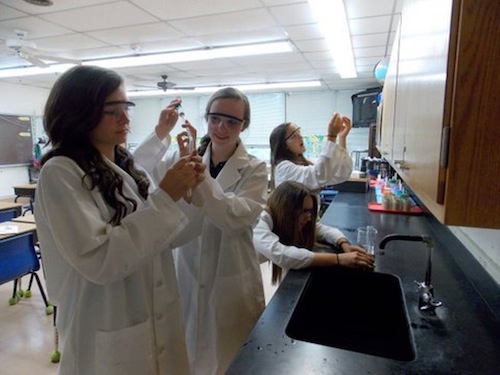
A team of eighth grade student researchers practice protocols for prepping the FME mini-lab for spaceflight.
Proposal Summary:
We are proposing to send Dry Lake Fairy shrimp to the ISS. We are hoping to discover if microgravity affects the muscle of these shrimp. We hypothesize that if we hatch Dry Lake Fairy Shrimp eggs in microgravity, then the hatched shrimp would be smaller, underdeveloped, and unable to swim because of lack of muscle. We chose Dry Lake Fairy Shrimp because they are small in size and we believe that we could relate our findings to the muscle loss astronauts endure in microgravity. By doing our experiment, we can broaden our understanding of muscle loss in microgravity and possibly find a way to prevent it.
We want to know what will happen to the shrimp if they are hatched and develop in microgravity. We believe that when the eggs are submerged in water up in space, when and if they start to grow, they will develop with much less muscle mass and possibly growth defects or develop in an irregular shape or size.
We would like to see if the development of the Dry Lake Fairy Shrimp’s muscle loss compares in any way to the muscle loss of the astronauts. We have seen other studies where some animals lose a larger percent of muscle mass compared to astronauts. We are wondering if it has the same effects on shrimp.
HONORABLE MENTION FINALISTS:
The Effects of Imiquimod Cream on Melanoma Mutations
Grade 7, Saint Augustine Cathedral School, Diocese of Kalamazoo
Teacher Facilitator: Thomas Maihofer, Middle School Science Teacher
Proposal Summary:
In our experiment we are trying to discover whether gravity plays a role in cell replication with the drug Imiquimod. Scientists grow and reproduce cells on Earth in petri dishes to replicate as best as possible what happens in the human body. Melanomas are very common with all people. Our research suggests Imiquimod, a medication that fights melanomas, would be the most appropriate option to treat melanomas in 1-g and 0-g environments.
In a microgravity environment we can test the melanoma in a way [that would mirroring how it] would react in a human body under these conditions. This could revolutionize the way doctors and scientists look at cancer.
A skin cancer diagnosis is devastating. Skin cancer manifests itself in the tissue of the epidermis. This makes it very hard to treat for skin cancer. With our research we could find easier ways to treat melanomas.
We will see the effect of Imiquimod cream on melanoma cells and observe how they are killed. We will do this by putting advanced melanoma cells in the middle [Volume 2] of the FME mini lab; in Volume 1, we’ll have the cream. In Volume 3 we will have the fixative. When it reaches a microgravity environment we will open clamp A, exposing the cancer cells to the Imiquimod, then we’ll open clamp B. Doing this experiment, we will learn how Imiquimod will affect melanoma cells in an environment that mimics the human body in microgravity. This will give scientists insight on the effectiveness of Imiquimod cream in space.
Will Microgravity Affect the Regeneration of a Planarian Worm?
Grade 7-8, St. Stanislaus Catholic School, Diocese of Kalamazoo
Teacher Facilitator: Randi Restau
Proposal Summary:
We propose to answer this question: Under the effects of microgravity, will a Planarian worm still regenerate the same? According to our research, we understand that oxygen has a big role in the regeneration process. In limited gravity, there will be limited oxygen. In turn, we think that the regeneration process will take longer because of this. We also hope to discover if the regeneration process will be changed because of microgravity. We hypothesized that the worm will mutate in microgravity, because the loss of gravity might be too great for the worms to comprehend. Also, we observed the regeneration in a video and we think that the Planarian might die due to the loss of gravity.
7. Madison Heights, Michigan
Jump to Madison Heights’ Community Profile
SELECTED FOR FLIGHT:
Coliform Bacteria
Grade 7, Wilkinson Middle School, Madison District Public Schools
Co-Principal Investigator: Farah Sabah
Co-Investigators: Israa Alfadhli and Regina Alsabagh
Collaborator: Maryam Kafra
Teacher Facilitator: Angel Abdulahad, Enrichment Teacher
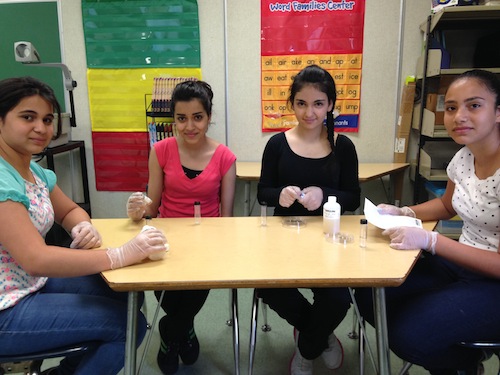
(l to r) Israa Alfadhli, Farah Sabah, Regina Alsabagh, and Maryam Kafra working on their E. Coli sample.
Proposal Summary:
This experiment will test the effects of microgravity on the interaction of Iodine tablets with Coliform infected water. We plan on doing the following experiment: Mixing Iodine tablets with coliform infected water while gravity is “shut off” on the International Space Station (ISS).
Our proposal will examine whether the effects of Iodine tablets are similar to the results conducted here on Earth. We will conduct a similar experiment with the only variance being gravity. Both bacterial samples will be examined and tested using a water purification test kit provided at the local hardware store [before launch]. The test will be conducted [again] once the water sample arrives back from the International Space Station. The reason for this experiment is twofold, one being, water is recycled on the ISS using a water filtration system because the weight of the water prevents the Space program from sending water to the ISS for daily use for their astronauts. Secondly, an unknown water source might be discovered while exploring planets and lands both on Earth and in space where water will need to be treated.
HONORABLE MENTION FINALISTS:
The Effects of Microgravity on Apples
Grade 6-8, Wilkinson Middle School, Madison District Public Schools
Co-Principal Investigators: Carley McNitt and Marianna Smith
Co-Investigator: Melissa Grande
Collaborators: Maisam Raouf and Kaitlyn Shepherd
Teacher Facilitator: Angel Abdulahad, Enrichment Teacher
Proposal Summary:
Our experiment is to test the effect of microgravity on dehydrated apples. Our proposal is to rehydrate the apples using water and then apply lemon juice in order to slow down the oxidation, browning, and decaying of the apple surface. We intend to do this by conducting a simultaneous experiment both on Earth as well as on the International Space Station (ISS). We will utilize an approved [mini-lab] that will house dehydrated apples, lemon juice concentrate, and water to run the experiment. We will introduce the dehydrated apples to water, thus rehydrating them. After rehydration, lemon juice concentrate will be introduced and then the apples will be examined for the effects of microgravity on the oxidation, browning, and decaying of the apple surface. This experiment could help the environment by reducing food waste, and adding nutritional value to it. This experiment will be helpful for people on Earth, people in space, and homeless people.
Rusting with Microgravity
Grade 8, Wilkinson Middle School, Madison District Public Schools
Principal Investigator: Brandon Istifou
Co-Investigators: Peyton Leach and Carlie Prell
Collaborators: Rancy Hanna and Angelo Tomika
Teacher Facilitator: Angel Abdulahad, Enrichment Teacher
Proposal Summary:
Our experiment is going to examine how the effects of microgravity will affect the amount of rust that forms on a piece of an iron nail in saltwater. We believe that this question is important because it has many benefits since iron is used to make steel components that are found in vital parts of construction on Earth and in space. Iron is a pure element; it can be mixed with carbon to form an alloy, called steel. As we become space travelers and our equipment is made of metal that can rust, corrode, or weather, this becomes even more important. In fact, our research found that one time there was a problem on a spacecraft due to corrosion of one of the wires. Even though the wires were copper, all metals can corrode or weather due to moisture. Our team chose to use saltwater because it would speed up the oxidation process on the iron nail. We will be conducting the same exact experiment here on Earth so that we can tell the difference in amounts of rust that have formed.
8. Kansas City, Missouri
Jump to Kansas City’s Community Profile
SELECTED FOR FLIGHT:
Biocides and Bacteria
Grade 7, St. Peter’s School, Kansas City – St. Joseph Diocese
Co-Investigators: Nicole Ficklin, Holden O’Keefe, and Eamon Shaw
Teacher Facilitator: Robert J. Jacobsen, Seventh and Eighth Grade Science Teacher
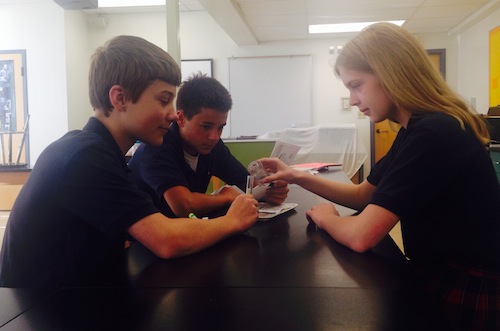
Team co-investigators Nicole Ficklin, Eamon Shaw, and Holden O’Keefe preparing their FME mini-lab to study the effect of iodine upon E. coli reproduction in microgravity.
Proposal Summary:
The co-investigators would like to determine the effects of the antibacterial cleaning agent liquid iodine against Escherichia coli bacteria in the microgravity of the International Space Station as compared to the effects of liquid iodine on E. coli in the gravity on Earth.
Microbes, specifically bacteria, are present on the ISS; if there were to be an outbreak of a harmful strain of bacteria on the ISS, it would be imperative to eliminate the aforementioned strain as completely as possible. For this reason, the co-investigators would like to determine the difference in the amount of E. coli bacteria eliminated by liquid iodine in microgravity versus gravity.
HONORABLE MENTION FINALISTS:
How is Capillary Action Affected by Microgravity?
Grade 6, Home School Group
Co-Principal Investigators: Ted Brull, Grant Fussell, and Ethan Mick
Teacher Facilitator: Richard Brull
Proposal Summary:
We propose to answer the question: How does microgravity affect capillary action? Capillary action is the ability of a liquid to flow in narrow spaces without the assistance of, and in opposition to, external forces like gravity. It occurs because of intermolecular forces between the liquid and surrounding solid surfaces. A good example of capillary action is wicking. Paper towels absorb liquid through capillary action.
We believe that capillary action can be used to create an efficient, compact, filter which can fit into a considerably smaller amount of space than current filters. A more efficient filter may also help astronauts not have to transport as much water. It is important to understand how water can be efficiently filtered in space in order to provide a clean water source for the astronauts, require fewer resources, and decrease both fuel costs and need for storage space.
Will the Growth Rate of Plants Increase in Microgravity?
Grade 8, Rosedale Middle School, Kansas City Public Schools
Principal Investigator: Angelina Hagstrom
Co-Principal Investigators: Jacqueline Arambula, Genesis Garcia, Nancy Guttierrez, Sandra Marquez, and Laura Yac
Teacher Facilitator: Samuel Martin, Mathematics Teacher
Proposal Summary:
Our team’s focus is the effect of microgravity on the growth rate of plants. With plant life being so abundant on Earth and a part of our daily lives, we wondered if we can bring plants, flowers, and vegetables to space with us. Various plants grow differently on Earth, so how would they grow in a microgravity environment? We plan to prove that the growth rate of plants will increase in microgravity. We predict that without the effect of gravity on plants, they will grow faster and taller.
9. Berkeley Heights, New Jersey
Jump to Berkeley Heights’ Community Profile
SELECTED FOR FLIGHT:
Baby Bloodsuckers in Outer Space
Grade 7, Columbia Middle School, Berkeley Heights School District
Co-Principal Investigators: Julia Ellis, Kasia Kapustka, Gia LaSalle, Bianca Urbina, and Lilyana Walsh
Teacher Facilitator: Pamela Wilczynski, 7th Grade Science Teacher
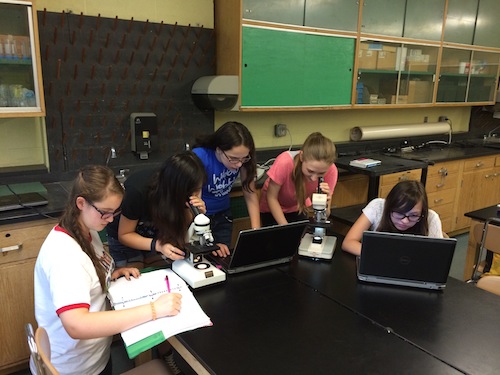
Lily Walsh, Gia LaSalle, Julia Ellis, Kasia Kapustka, and Bianca Urbina examine mosquito larvae and survival rates in support of their SSEP proposal.
Proposal Summary:
Our experiment will be to test the development of Aedes albopictus mosquito eggs in microgravity as compared to normal gravity. When launched, the eggs will be dry so when a clamp is released, water will activate the fertilization of the eggs. We believe the eggs will hatch and mature into larvae even in microgravity. On Earth, the larvae float to the surface of water to breathe and mature into pupae. We will have the astronauts preserve the mosquitoes shortly after they should have matured into pupae. However, without gravity we believe the larvae will lack a mechanism to rise to the surface and therefore will fail to mature. On Earth we will perform the same experiment. After both experiments are completed, we will observe the differences between both specimens.
HONORABLE MENTION FINALISTS:
Helium Adsorption in Single-Walled Carbon Nanotubes
Grade 11, Governor Livingston High School, Berkeley Heights School District
Co-Principal Investigators: Isha Mehrotra and Shree Mehrotra
Co-Investigators: Sarah Cohen, Emily Herring, and Zoya To
Teacher Facilitator: James Flakker, Physics Teacher
Program Summary:
Hydrogen fuel has been an issue for decades because, despite its potential, hydrogen gas is difficult to store safely. A recent technology, single-walled carbon nanotubes (SWCNTs), has the ability to store hydrogen gas, but the process is inefficient on Earth. However, the adsorption of hydrogen gas in SWCNTs is likely to be more effective in a microgravity environment, where capillary forces will be significantly stronger in the absence of an opposing gravitational force.
Hydrogen adsorption cannot be tested due to safety constraints, but helium gas is a close substitute. The two possess similar characteristics, including their capillary forces. In the experiment, the first volume of the Type 2 FME will have helium gas with a clamp separating it from a bundle of SWCNTs in a vacuum. Upon arrival at the International Space Station (ISS), the clamp will be opened for the helium gas to be adsorbed into the SWCNTs. The mass of helium adsorbed will be measured by calculating the integral of the spectrum generated through temperature programmed desorption (TPD). The weight percentage will be compared to that of the ground-truth experiment to assess the difference in efficiency.
Hydrogen is a major fuel source on the ISS. To cool hydrogen enough for liquid fuel usage is difficult; thus, gaseous hydrogen storage in SWCNTs will simplify the process. SWCNTs have the potential to revolutionize hydrogen fuel storage, and the adsorption of helium will provide insight into the viability of this alternative for hydrogen storage.
Reactivation and Virulence of Human Papillomavirus Type 16 in a Microgravity and Elevated Radiation Environment
Grade 10, Governor Livingston High School, Berkeley Heights and Mountainsides School Districts
Principal Investigator: Christopher Weeks
Co-Investigator: Alexander Ju
Collaborators: Amanda Bostwick, Andrew Clark, and Duylinh Vu
Teacher Facilitator: Dr. Meredith Morgan, Instructor
Proposal Summary:
We propose to study the reactivation and virulence of human papillomavirus in a microgravity environment. Prior research has shown dormant Epstein-Barr virus reactivated within their host cells in conditions of low gravity and high radiation. It is postulated that microgravity inhibits many cellular processes, including immunological response, while radiation exposure is presumed to damage nucleic acids and to induce oxidative stress.
Like Epstein-Barr virus, human papillomavirus (HPV) afflicts the majority of the human population and is believed to remain dormant in most infected persons. However, HPV can cause genital warts and cancers of the cervix and genital tract as well as oropharyngeal cancers. The proposed theory is that oxidative stress and other inhibitive conditions play a crucial role in facilitating HPV infection, replication, and carcinogenesis.
In the absence of published research on the behavior of HPV in microgravity, we believe an experiment that examines this subject would yield useful data on a potential threat to astronauts and will further the knowledge and understanding of HPV infection and its complications.
Our proposed experiment is to reactivate dormant cervical epithelial cells infected with HPV-16 on the ISS and allow the culture to develop for nine days. At the end of the experimental period, the cells will be preserved in formalin and returned to Earth for analysis. An identical control experiment will be performed on Earth for comparison.
We hypothesize that exposure to an environment with microgravity and high radiation will reactivate human papillomavirus and increase its virulence.
10. Long Branch, New Jersey
Jump to Long Branch’s Community Profile
SELECTED FOR FLIGHT:
Hydroponics vs. Microgravity
Grade 5, Gregory School, Long Branch School District
Co-Principal Investigators: Zachary FitzGerald, Ronnie Gibson, Jonathan Rocha, and Michael Zapcic
Teacher Facilitator: Laura Lazzati, 5th Grade Teacher
Proposal Summary:
Our proposal is to determine whether or not hydroponics will be different in space than on Earth in terms of [plant] size, color, and taste. We are doing this proposal because we are trying to see if hydroponics is more efficient in space than on Earth. We are trying to solve the problem of world hunger. Hydroponics might help solve the issue of world hunger if we can determine if food can be grown faster in space. Since hydroponics is more efficient on Earth, it might be even more efficient in space so that the world hunger problem might be solved by space hydroponics, which will feed the poor and hungry people of the world. In terms of size, a hydroponic [garden] might be bigger or smaller or it might just stay the same. In terms of taste, [plants] might taste better or might taste worse [compared to those grown using] Earth hydroponics.
Today, hydroponics on Earth is more efficient than plants grown in soil. Our one concern is that space hydroponics could have a negative effect by altering the growth structure of the plant. If this is the case, we may be unable to use any hydroponic growth in space if we don’t know the effects of the altered growth structure. We chose to do our proposal on hydroponics because we think this is a unique idea and we are interested to explore the results.
HONORABLE MENTION FINALISTS:
Cell Reproduction
Grade 11-12, Long Branch High School, Long Branch School District
Co-Principal Investigators: Elizabeth Castrillon, Manuel Camacho-Lemus, Samuel Hernandez, and Axel Perez
Teacher Facilitator: Mr. Keagle, Physics Teacher
Proposal Summary:
The team’s focus is on the cell wall structure and the reproduction of plant cells through mitosis in a microgravity environment. If cells reproduce in microgravity conditions it is both important on Earth and space because plants are substantial to life everywhere. We believe that plant cells in a microgravity environment will reproduce at a slower rate than on Earth. We will use an enzyme to cause a reaction to start reproduction and use an inhibitor to stop the reproduction after a required amount of time. Once we determine the behavior of a plant cell in a microgravity environment we can determine if it’s possible for plant life to flourish in space.
There’s a Fungus Among Us
Grade 11, Long Branch High School, Long Branch School District
Co-Principal Investigators: Ariana Murray, Lorena Pessoa, Ashley Reyes, Jessica Rojas, and Nichelle Serrano
Co-Investigator: Jazlyn Delgado
Collaborators: Drew Jackson, Alex Guiz, Adriann Tutt, and Michael Vasquez
Teacher Facilitator: Jena Carpenter, Science Teacher
Proposal Summary:
The purpose of the experiment is to figure out how much mold would be produced in a matter of six weeks in zero gravity. On Earth it takes a matter of seven to ten days for mold (depending on the type of bread) to begin growing on white bread at a temperature of 21.1 degrees Celsius (70 degrees Fahrenheit) or higher. The reason for the experiment is to figure out how long regular day-to-day foods on Earth last in space without becoming inedible. This will be calculated based on the rate of growth on the International Space Station in comparison to rate of growth on Earth. Bread is being used because it is a common food.
11. Ocean City, New Jersey
Jump to Ocean City’s Community Profile
SELECTED FOR FLIGHT:
Attachment of Escherichia coli K-12 Strain to Lettuce
Grade 11, Ocean City High School, Ocean City School District
Co-Principal Investigators: Lauren Bowersock, Mercy Griffith, Kristina Redmond, Daniel Loggi, Kaitland Wriggins, and Alison Miles
Teacher Facilitator: Catherine Georges, Honors Biology Teacher
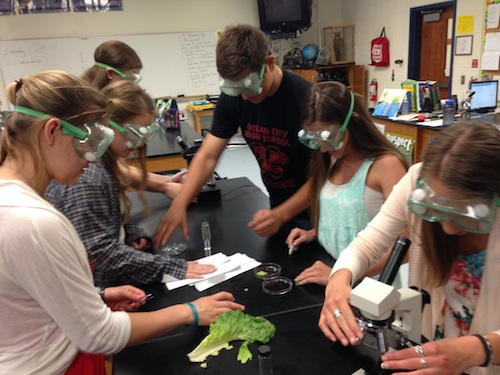
Lauren Bowersock, Kristina Redmond, Alison Miles, Dan Loggi, Kati Wriggens, and Mercy Griffith prepare lettuce slides for their study of the attachment rate for E. coli in microgravity.
Proposal Summary:
Conditions in space have a profound impact on the human body and all living organisms are affected by microgravity. For our experiment, we chose to examine the impact microgravity has on Escherichia coli K-12’s attachment rates. Previous studies have shown that microgravity increases bacterial reproduction rates, however our group chose to look at the effect microgravity has on bacteria’s attachment rates. We hypothesize that microgravity will inhibit E. coli’s ability to attach to a host. Reduced rates of E. coli attachment can be beneficial to astronauts if they are exposed to a pathogenic strain; however, these reductions can also be severely detrimental to the human body. Inhibited attachment of the commensal strains of E. coli that reside in the colon, which assist in digestion, food absorption and vitamin K processing, can also be detrimental for human health. E. coli K-12 is a refined lab strain of E. coli that has been found to attach to lettuce. In space, we will expose E. coli K-12 to lettuce for a number of days. Before the end of the experiment, we will expose both the E. coli K-12 and the lettuce to a fixative, formalin, which will kill the bacterial cells, freezing them in their positions attained in space in order for accurate analysis on Earth. Studying E. coli K-12’s rate of attachment is crucial for the advancement of science in space exploration.
HONORABLE MENTION FINALISTS:
Blood Coagulation in Space
Grade 9 and 12, Ocean City High School, Ocean City School District
Co-Principal Investigators: Hiba Ahmad and Maham Ahmad
Co-Investigator: Kimberly Brown
Collaborators: Liam Bradley and Elizabeth May
Teacher Facilitator: Catherine Georges, 9th Grade Biology Teacher
Proposal Summary:
Our experiment is designed to answer this question: To what degree do changes in gravity affect basic blood function of coagulation, both during and right after spaceflight? We will send a sample of citrate plasma into space, and have it mix with calcium ions to initiate clot formation. This mixture will be exposed to the same gravity conditions as astronauts, both during the spaceflight itself and when it reaches terrestrial Earth. With this sample and a control group on Earth, we can compare the presence of fibrinogen, any changes in intracellular calcium levels, and structure of coagulation enzymes in the plasma. We predict that the level of coagulation will form slower in microgravity conditions, but upon reaching Earth increasing its level of coagulation to surpass that of the control group. Calcium levels of intercellular fluid may be higher as well. By analyzing the human blood’s capacity to clot and produce fibrin in microgravity, we are expanding on the potential to improve the safety of astronauts in space, and therefore are coming one step closer to removing the barrier between humanity and what lies beyond.
A Study of Snails in Microgravity
Grade 10-11, Ocean City High School, Ocean City School District
Principal Investigator: Gregory D. Fisher
Co-Investigator: Hannah K. Lucey
Teacher Facilitator: Keith A. Zammit, Chemistry, Physics and Physical Science Teacher
Proposal Summary:
We would like to study the use of snails as a renewable food source for fish and controlling an algae population in microgravity. Fish are being considered as a food source for potential space colonies and long-term missions. We believe that algae would be a viable oxygen source for the fish, and that snails would be able to keep the algae population under control. A type two FME mini-lab would contain pond snails and enough algae essential for survival until arrival on the ISS. The other side of the mini-lab would contain algae to be used as food and oxygen source for the snails. Upon arrival on the ISS, the clamp would be removed, mixing the two sides together. Astronauts would not disturb it for the rest of its time spent on the ISS. The same procedure would be followed for the ground truth experiment. Once the mini-lab returns to Earth, we would test the dissolved oxygen level in the water of each mini-lab. The results would be compared and a conclusion would be drawn. The individual snails from the experimental group would be studied with microscopes and compared with the snails from the control group to determine whether or not microgravity affected the growth of the snails. This experiment would further our understanding of how microgravity affects animal growth. It would also be a step towards determining or not snails can be used as a renewable food source for fish and controlling an algae population in space.
12. Flushing, New York
Jump to Flushing’s Community Profile
SELECTED FOR FLIGHT:
Can Zero Gravity Affect the Germination of Chia Plants?
Grade 7, World Journalism Preparatory School, New York City School District 25
Co-Principal Investigators: Ethan Reres, Gabriella Marin, Jamila Tejada, Michael Fourniotis, and Raul Castrejon
Teacher Facilitator: Christian VanDeurs, 7th Grade Science Teacher, and Dr. Mark Baribault, Chemistry/STEM Teacher
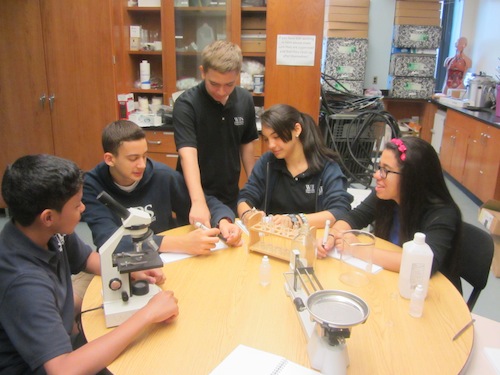
WJPS student researchers discussing data recorded in support of their chia seed microgravity experiment.
Proposal Summary:
We want to know if reduced gravity will have an effect on chia seed germination. We’re doing this experiment by comparing the number and size of germinated seeds in normal gravity, compared to microgravity. This experiment will have an impact on humanity because it will show if reduced gravity has an effect on seed growth.
HONORABLE MENTION FINALISTS:
The Effect of Microgravity on Aging and Longevity
Grade 9, World Journalism Preparatory School, New York City School District 25
Co-Principal Investigators: Cleo Zhang and Nicole Yu
Co-Investigator: Howie Chen
Teacher Facilitator: Dr. Mark Baribault, Jessica Cimini, and Georgia Douvres, High School STEM Teachers
Proposal Summary:
We decided to experiment on whether or not Docosahexaenoic acid (DHA), an omega-3 fatty acid that had been tested positive in prolonging fruit fly lifespan in space, can actually make daphnias live longer in space. We are aware that long exposure to microgravity in space can decrease an organism’s longevity. This is especially obvious in short-lived organisms. Drosophila Melanogaster, a type of fruit fly was proven to have a shorter life span when they were exposed to microgravity for long periods of time in other experiments. We wanted to see if this also works on other organisms – specifically ones that are somewhat related to the human body’s characteristics.
If daphnia, under the aging acceleration of microgravity, can live longer with the dosage of DHA, then it would be true that DHA can improve the lifespan of organisms in microgravity conditions. And based on that, we can research further with more knowledge for secrets behind human’s longevity and medications for astronauts in space that are aging quicker because of microgravity’s influences.
The Physiological Effects of Pseudomonas Aeruginosa on Caenorhabditis Elegans
Grade 9, World Journalism Preparatory School, New York City School District 25
Principal Investigator: Amina Chowdbury
Teacher Facilitators: Dr. Mark Baribault, Jessica Cimini, and Georgia Douvres, High School STEM Teachers
Proposal Summary:
The focus of this experiment is to observe how microgravity affects the physiology of the bacteria Psuedomonas Aeruginosa on the nematode Caenorhabditis elegans. From the outcomes of previous experiments in gravity, similar to this, I have come to the prediction that microgravity will decrease the life span and have drastic physical effects on the nematodes body at a quicker rate in microgravity that on Earth where gravity is present. This experiment requires that the P. aeruginosa strain be in contact with the C. elegans strain so that physiological effects could be observed later on. When the experiment is sent back to Earth, the life span will be measured, and the drastic physical effects on the nematodes body will be observed, comparing the results with the same experiment that occurred on Earth. If there is a decrease in the life span and there are physical effects on the nematode’s body at a quicker rate in microgravity than on Earth where gravity is present, then it shows that microgravity can make P. aeruginosa more harmful to living organisms than in an environment with gravity. The results of this experiment will provide researchers with more information regarding the effects of microgravity on P. aeruginosa. This could then be a prediction on the amount of damage that P. aeruginosa and possibly other bacteria could have on humans in space. Researchers could then act accordingly on how to prevent specific diseases that could affect humans and any living organism in microgravity as well as in Earth.
13. Colleton County, South Carolina
Jump to Colleton County’s Community Profile
SELECTED FOR FLIGHT:
Milk in Microgravity
Grade 6, Colleton County Middle School, Colleton County School District
Principal Investigator: Bailey Crosby
Co-Investigators: Amber Avant, Morgan Dandridge, Megan Dewitt, and Casey Powell
Teacher Facilitator: Ann Henson, 6th Grade Science Teacher
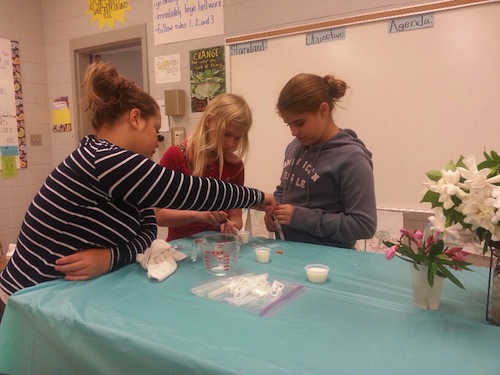
Future doctors Dewitt, Crosby, and Dandridge preparing a Fluid Mixture Enclosure mini-lab for their milk in space experiment.
Proposal Summary:
Our group is trying to figure out what type of milk will spoil the most in 6 weeks time spent in microgravity. The three types of milk we are using are whole, skim, and 1% milk. After doing research for two hours in the library, we found out that whole milk spoils the fastest on earth and skim milk takes the longest to spoil. The reason for this is because of the amount of coliforms in different types of milk. Since bacteria can grow and reproduce asexually, they can reproduce into larger groups faster. Not to mention that bacteria, which is the product of milk spoiling, can grow in any temperature. A benefit is, if you want to drink milk because it has vitamins and nutrients, you need to see which one will stay fresh the longest. Another benefit of this project is, if one day they find out that humans could possibly live in space, we would need something to drink other than water. We are expecting to find that the results of our experiment will fit our hypothesis which is that whole milk will spoil more in space and on Earth than skim and 1% milk. We will observe the amount of curdles in each section of both FMEs to determine which spoiled the most.
HONORABLE MENTION FINALISTS:
What is the Effect of Microgravity on the Growth of Epsom Salt Crystals?
Grade 6, Colleton County Middle School, Colleton County School District
Principal Investigator: Sarah Ward
Co-Investigators: Adriene Jenkins, Ashlyn Williams, and Essence Wright
Teacher Facilitator: Saundra Eugene, 6th Grade Science Teacher
Proposal Summary:
What is the effect of microgravity on the growth of Epsom salt crystals? Crystals are solids that form by a regular repeated pattern of molecules connecting together. Crystals are utilized in various ways including medication and electronics. Some crystals used as medication have been found to be effective in the treatment of viral disorders and prostate cancer. In some circumstances when dealing with electronics, crystals allow radios to convert electrical energy into vibrations. Therefore, investigating crystals has many relevant applications. Because we know that crystals are formed through the process of evaporation, we propose that microgravity will enhance their growth.
Evaporation in Microgravity
Grade 6, Colleton County Middle School, Colleton County School District
Principal Investigator: Selvin Villalobos
Co-Investigators: JaKeem Cochran, Amonie Koger, and Taylor Stevenson
Teacher Facilitator: Ann Henson, 6th Grade Science Teacher
Proposal Summary:
In our group, we are trying to see if water will evaporate in microgravity. We already know water will evaporate on Earth. We are doing this to see if water is more likely to evaporate in microgravity than on Earth. The materials that we will use in this project are: 14 milliliters of distilled water, a syringe and the FME Type 1 Mini-Lab. This project would help us to know how much water plants and crops will need if we moved to somewhere in the galaxy. If everything just floats, then there would be no way to contain the water so that growing food couldn’t happen and there would be no chance of survival. We are interested in knowing if water evaporates in microgravity so that water could condense into clouds like we studied about the water cycle on Earth. We also learned that all of Earth’s weather occurs in the troposphere. Our hypothesis is that water will NOT evaporate in microgravity because of the lack of gravity.
14. North Charleston, South Carolina
Jump to North Charleston’s Community Profile
SELECTED FOR FLIGHT:
How Does Spaceflight Affect the Formation of Tin Whiskers on Lead-free Solder?
Grades 9 and 11, Palmetto Scholars Academy, South Carolina Public Charter School District
Co-Principal Investigators: Joseph Garvey and Rachel Lindbergh
Collaborator: Gabriel Voigt
Teacher Facilitator: Kellye Voigt, Science/Research Teacher
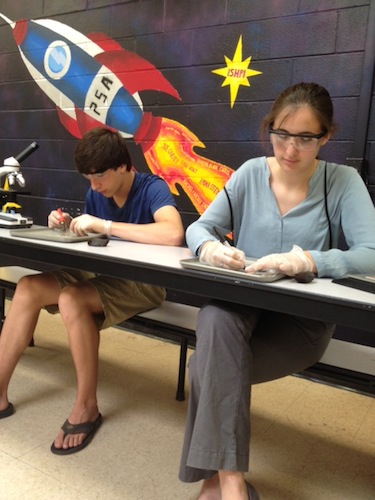
PSA Principal Investigators practice soldering and working with copper clad, fiberglass circuit boards.
Proposal Summary:
Tin whiskers – the crystalline structures that originate from metals covered in or plated with tin – have become a serious problem for electronics manufacturers and scientists. These tin whiskers can short-circuit devices by creating a new electrical current. In fact, tin whiskers have even been known to destroy planes and satellites, resulting in not only considerable risk of human life but in the loss of hundreds of millions of dollars. Tin whiskers have caused the destruction of the Galaxy IV, Galaxy IIIR, and Solidaridad 1 satellites, and more.
Our group is interested in testing the entire experience of spaceflight on the development of tin whiskers, including the launch and re-entry. We believe that the g-force experienced in the journey to and from the ISS and microgravity experienced on the ISS will promote the growth of tin whiskers on the tin-plated testbed and the printed circuit board. We will also utilize a procedure created by Dr. Lyudmyla Panashchenko, a NASA scientist in the Electronic Growth and Packaging program, to maximize the possibility of tin whisker growth on the testbed.
To test our hypothesis, our team would send a lead-free solder testbed to the International Space Station to compare the development of tin whiskers with the control testbed that would remain on Earth. We will analyze the mass of the sample, length, structure, and density of the whiskers. The results of our experiment would increase our current understanding of the effects of spaceflight and microgravity on the stability of electronic devices sent to space.
HONORABLE MENTION FINALISTS:
How Does Microgravity Affect the Structural Integrity of 3D Printed Hytrel Tensile
Grades 7, 9, and 10, Palmetto Scholars Academy, South Carolina Public Charter School District
Co-Principal Investigators: Kayla Capitan, Delaney Chariker, and McKoy Floyd
Teacher Facilitator: Kellye Voigt, Science/Research Teacher
Proposal Summary:
This proposal will test the structural integrity of 3D-printed tensile bars made of acrylonitrile butadiene styrene (ABS) and Hytrel, two common plastics used in 3D printing, in microgravity. The impending arrival of a 3D printer on the ISS this fall makes this experiment crucial to the understanding of how different materials would operate and how the layering of polymers created by 3D printing would stay intact. Hytrel is a thermoplastic polymer made by DuPont. ABS is the current material that will be used in the 3D printer being sent to space. A 3D printer in space offers a wide range of capabilities that astronauts did not have before, reducing the current limitations caused by cost, size, and transportation by allowing for in-space manufacturing of tools/parts. It will also enhance the safety for astronauts during spaceflight and give them the ability to manufacture parts on-demand. Using type 2 FMEs, we will load ABS 3D printed tensile bars in one volume of each FME and 3D printed Hytrel tensile bars in the other volume of each FME. We will compare the ground elements bars with the microgravity bars after the experimental tensile bars return to Earth. We will test their yielding strength, ultimate strength, necking, and rate of yield using a tensile machine at DuPont. We will also be analyzing the polymer layers of the bars using a scanning electron microscope (SEM) from the College of Charleston.
Growth Acceleration and Seed Structure of Solanum lycopersicum After Exposure to Microgravity
Grades 9 and 11, Palmetto Scholars Academy, South Carolina Public Charter School District
Principal Investigator: Rachel Lindbergh
Co-Collaborators: Trip Bastian, Nicholas Guiffreda, Nicole Lindbergh, and Zach White
Teacher Facilitator: Laura Stevens, Physics Teacher
Proposal Summary:
For years, the 1,250 year old “Chujo-hime-seigan-zakura” cherry tree had produced almost no offspring, until around 265 of its cherry stones were brought to the International Space Station. Most of the stones were sent to laboratories afterwards, but fourteen were planted across Japan. Many of these trees bloomed years early, one even after two years instead of the typical ten years. In addition, the trees produced flowers with as few as five petals, instead of the average thirty petals per flower.
Since the stones were not brought to the ISS as an experiment, there was not a control group. Therefore, it is unknown if this anomaly is caused by the exposure to microgravity. If that is the case, the discovery could radically alter agribusiness. Seeds could be sent to the ISS to accelerate growth by years. Continued testing with a widely used plant that matures in less time should occur to investigate the results found with the cherry trees.
To test this, our group will be sending thirty-five Solanum lycopersicum or Alicante heirloom tomato seeds in a type 1 FME to the ISS, with four, thirty-five seed control group. Fifty of these seeds will be planted and compared to a control group that is kept on Earth, and twenty will be analyzed. The S. lycopersicum was chosen because they mature in about two months, grow in late spring and early summer, and “breed true”, creating genetically similar plants.
15. Knox County, Tennessee
Jump to Knox County’s Community Profile
SELECTED FOR FLIGHT:
Waste in Space: Exploring the Effect of Microgravity on the Rate of Decomposition of Corn Starch by Rid-X
Grades 5-11, L&N STEM Academy, Knox County School District
Co-Principal Investigators: Lydia Barbour and Ethan Fawver
Co-Investigators: Forrest Hamilton, Hunter Hawkins, Sarah Sellers, and Thomas Tison
Collaborators: Nick Corbett, Henry Gertsen, and Jonathan Tison
Teacher Facilitator: David Hawkins and Nick Wilsey
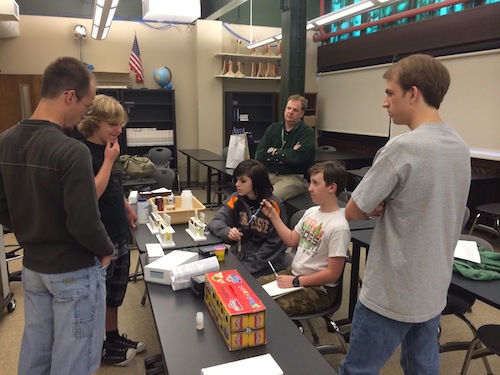
(l to r) Mentor Nick Wilsey, Nick Corbett, Sarah Sellers, mentor Nick Sirek, Ethan Fawver, and Henry Gertsen conferring on baseline setup for ground truth experiments.
Proposal Summary:
The purpose of our experiment is to determine the effect of microgravity on the rate of decomposition of corn starch by Rid-X, a commercial septic treatment product. Rid-X contains enzymes and bacteria, which work together to decompose organic waste and produce carbon dioxide. Some of the carbon dioxide will remain dissolved in the fluid to form carbonic acid. We will measure the rate of decomposition by titrating the fluid in our experimental and control tubes with sodium hydroxide, which will tell us the amount of carbonic acid produced by the bacteria. We will terminate the experiment with ethanol. We chose corn starch as our food source and ethanol as our terminating agent because they are pH-neutral, allowing us to measure the small amount of acid produced by the bacteria. We predict that the rate of decomposition will be slower in microgravity because Rid-X is designed to work in a septic system, which is stratified into layers on Earth by gravity. In microgravity, we expect that the bacteria and enzymes in the Rid-X and the corn starch will float around in clumps. The enzymes in Rid-X therefore should be more likely to find the corn starch and begin breaking it down for the bacteria to metabolize on Earth than in microgravity, because on Earth they both should sink to the bottom and mix in the layer of sludge.
HONORABLE MENTION FINALISTS:
The Effect of Microgravity on Bacteria Growth on Alfalfa Sprouts
Grades 5, 7, and 10, Hardin Valley Academy, Knox County School District
Co-Principal Investigators: Thorin Heselschwerdt, Alex Parrish, and John D. Rison
Co-Investigators: Devon Edds and Trevor Edds
Collaborator: Allison Rison
Teacher Facilitator: Amber Hartman
Proposal Summary:
As we venture farther and farther from our home planet, the need for a sustainable food source will become essential for space travel. Alfalfa sprouts are an easily obtained source of food that can be grown easily on the space station. Alfalfa sprouts are rich in several nutrients. It has already been proven that plants can be grown in space and the nutrient values were comparable to those on earth. Sprouting the seeds can be easily accomplished in tubes containing the seeds and some water. However, when handled improperly, alfalfa sprouts can harbor dangerous bacteria, such as E. coli and salmonella.
Our experiment tests whether the bacteria on alfalfa sprouts grow faster in microgravity than they do on Earth. For this experiment, we will use trial and error to find the best seed, water, air ratio, then grow some sprouts and do a gram stain on them to find out what bacteria are on it.
Once we determine the best seed to water ratio we will add the seed to two Type 2 FME minilabs, one FME will go to the International Space Station where the astronauts will release the clamp to mix the seeds with water, which will allow them to sprout. The second FME will stay on Earth as a control. After the sample arrives back on Earth we will do a Gram test and a bacteria count, with the help of a laboratory, and compare it with the control sample.
Effect of Microgravity on Fruit
Grade 6, Bearden Middle School, Knox County School District
Co-Principal Investigators: Kate Atkins, Brooke Baxter, and Anna Lynn
Collaborator: Alex Skwarczynski
Teacher Facilitator: Julie Pepperman
Proposal Summary:
We are proposing an experiment to find the effect of microgravity on how dehydrated fruit reacts to a certain bacteria, and how that affects its decay or rotting. This experiment is composed of three factors: fruit A, which will be a kiwi, water mixed with the bacteria E. coli k12 wild, and fruit B, which will be an orange. They will be placed in this order in the tube. When the bacteria and water is mixed with the dehydrated fruits, we will get a good look at how bacteria that could possibly be exposed to the fruits can affect their decaying process and how long the fruit will last.
We chose this topic because the human body needs many of the nutrients in fruits to live a healthy and balanced life. Also, because of how quickly fruit decays, we need to figure out a way to keep them preserved. This experiment could help answer the questions that could lead to better fruit preservation for the astronauts. Dehydrated fruit was the perfect answer, so that you can just add water to the fruits. Finally, this could be a breakthrough to move on to the next stage of finding out how to continue our healthy diet to live a healthy life in space.
16. Somerville, Tennessee
Jump to Somerville’s Community Profile
SELECTED FOR FLIGHT:
Reishi Mushroom VS. Chronic Myeloid Leukemia
Grades 9-10, Fayette Academy, Independent School District
Principal Investigator: Mark Montague
Co-Investigators: Averi Davis, Harley Wade, and Tucker Whittington
Teacher Facilitator: Donna Burrus, Biology Lab Instructor
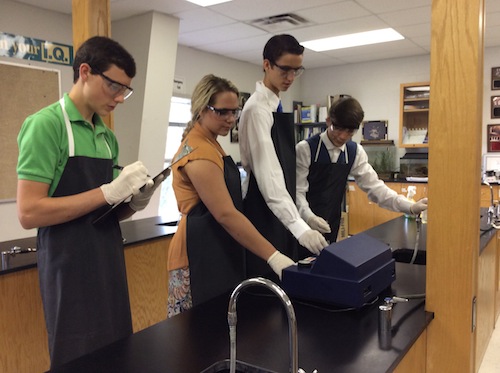
The Resihi mushroom research team learns how to use the spectrophotometer to record absorbance and transmittance data.
Proposal Summary:
Our team’s research question is, “What effect will microgravity have on the Reishi mushroom’s [Ganoderma lucidum] ability to weaken, damage, or destroy chronic myeloid leukemia cells?” Our project will send the Reishi mushroom and the K562 leukemia cells into a “free fall” environment. We will have three FME labs. One on board the ISS and the second one on the Earth with the same controls running simultaneously. The third one will run on Earth and will include K562 leukemia cells to see how rapidly they grow compared to the other FME tubes. This is important because we want to understand leukemia and how we can fight it with Reishi mushroom and how microgravity can affect it. Reishi mushroom has been used for over four thousand years in China and has shown promising effects. Cancer that starts inside bone marrow is chronic myelogenous leukemia [CML]. In the center of bones, there is soft tissue that helps form all blood cells. CML causes an untamed growth of immature cells that make myeloid cells, which are a certain type of white blood cells. We believe the Reishi mushroom will induce cell-cycle arrest and apoptosis in various human and cancer cells, which has been shown in past research done at UCLA (Muller I. Claudia, et al.).
HONORABLE MENTION FINALISTS:
Diffusion in Space
Grade 6, Fayette Academy, Independent School District
Co-Principal Investigators: Dunstan Ashe, Stone Hunt, Haven McLemore, and Matthew Walker
Teacher Facilitator: Donna Burrus, Biology Lab Instructor
Proposal Summary:
Our experiment is very important because the astronauts’ health depends on diffusion. What will happen if medicine that is vital to an astronaut’s health requires the diffusion process? It would be necessary for the astronaut to have the medication. If it does not work properly because of microgravity, sickness would be likely. If an astronaut gets ill and cannot get back to Earth for[ medical treatment], they would not improve.
There is a more important reason we need diffusion. Cells are the basic building blocks of all living things. Diffusion provides cell’s nutrients and get rid of their wastes. Without diffusion cells would die. Cells make up everything inside of you. Cells make up tissues, organ systems, and organisms.
For our experiment, we will be measuring the effect microgravity has on diffusion across a semi-permeable membrane. Our experiment will be sent up into space in a small tube where it may or may not diffuse properly. While the experiment is in space, we will be performing the experiment simultaneously here, on Earth. Once the experiment returns to Earth, we will compare the experiment the astronauts did to the experiment we did on Earth. We will be looking at how much dye is left in the semi-permeable membrane and how much dye is in the water, if either is still diffusing, and if one diffuses faster than the other. We will take before and after pictures of the experiment going into space and progressive pictures of the experiment on Earth.
The Rate at Which Cancer Cells Develop in Microgravity
Grades 10 and 12, Fayette Academy, Independent School District
Co-Principal Investigators: Jacob Bennett, Anna-Laura Currey, and Courtney Gilgen
Co-Investigators: Logan Enriquez and Adam Jamerson
Teacher Facilitator: Donna Burrus, Biology Lab Instructor
Proposal Summary:
We would like to propose an experiment involving the rate at which Chronic Myeloid Leukemia cancer cells grow in microgravity versus how they grow on Earth. We will place 8 ml of CML combined with media and 1 ml of puromycin (chemical used to stop cell growth) combined with media in the 10 ml FME. We will do this procedure on Earth as well to compare the different rates of growth. There will be one clamp to separate the CML and puromycin in the FME. At the end of the experiment the astronaut will undo the clamp and shake the FME for five intervals, combining the CML and the puromycin. According to past research, studies show that cancer cells in microgravity grow more similar to the way cells grow in the body. In microgravity, cells grow three-dimensionally where as in the lab they grow flat. Cells are still able to reproduce and grow in the lab but not as rapidly as they would in space because of their structure. At the end of the experiment we will use an electric microscope to look at the dead cells versus the live ones. We will use a dye called trypanblue to measure the cell growth. The dead cells are colored blue, leaving the live cells their natural color making it easier to count them and compare the live cells in microgravity compared to the live cells in the lab. We believe that this will help scientists to better understand cancer cell growth.
17. Rockwall County, Texas
Jump to Rockwall’s Community Profile
SELECTED FOR FLIGHT:
How Microgravity Effects Yeast Cell Division and How it Relates to Human Cancer Cells
Grade 8, Williams Middle School, Rockwall Independent School District
Co-Principal Investigators: Ryan Figert and Harrison Smith
Co-Investigators: Will Brown, Brooks Helmer and Chase Howerton
Collaborator: James Matthews
Teacher Facilitator: Mike Stone, Career and Technology Teacher
Proposal Summary:
This experiment is about how the division rate of yeast is affected by microgravity. Due to the recommendation of Derek Smith, a researcher at University of Texas Southwestern Medical Center, we plan to use yeast cells as a tool for modeling the cell division processes that occur in more complex cells like human cancer. We will use three volumes in the FME. The first compartment contains a yeast microorganism. The second compartment contains a yeast growth medium, YPD broth, which is usually used to grow the cells in a lab on Earth. The third compartment contains a fixative, glutaraldehyde, to stop the growth of the culture and preserve the results of the experiment for comparison to the ground experiment, which will be conducted in the exact same way, except for the gravity. From the results of this experiment, we can learn the possible effect of microgravity on cell division. If it slows or stops the division rate, the results will reveal methods that can be applied to studies on cancer cells. While in communication with Kartik Rajagopalan of University of Texas Southwestern, said, “Scientists and physicians are always looking for ways to cure cancer in human patients. If we find that microgravity causes a growth defect in cancer, it is possible that [time in microgravity] could be used as a therapeutic option for cancer patients.”
HONORABLE MENTION FINALISTS:
Escherichia coli Reactions to Microgravity
Grade 7, Herman E. Utley Middle School, Rockwall Independent School District
Co-Principal Investigators: Nathaniel Butler and Joseph Yeh
Teacher Facilitator: Marcus Edwards, Learning Designer
Proposal Summary:
How will the formation of E. coli colonies and its single cell morphology under microgravity be different from E. coli grown on Earth? From previous experiments in the ISS, scientists had found out that E. coli does indeed thrive better in outer space. We should however go deeper with this experiment to find out how the morphology and formation of the E. coli colony differ due to microgravity. We need to understand this finding so we will know how to effectively control this bacterium in space in the event of an infection outbreak. There may be people living on the ISS on a long term in the near future and having this knowledge can provide an effective way to control E. coli, preventing it from spreading. We need to conduct this experiment by using two colonies of E. coli, titanium dioxide, and Lysogeny broth (LB). We will first grow two colonies of E. coli in the lab using LB. We will take one colony to the ISS and one will stay in the lab. After two weeks we will plate them in a semi-solid medium and then look at their differences in their colony formation and morphology under fluorescent microscopes. This experiment can give scientists and astronauts insights regarding E. coli’s possible enhanced growth rate and resistance to human immunity under microgravity. We had consulted with Dr. Bruno Azevedo from the Department of Cell Biology, UT Southwestern Medical Center at Dallas, about different aspects of this experiment.
The Effects of Microgravity on Antibiotics
Grade 8, Williams Middle School, Rockwall Independent School District
Co-Principal Investigators: Parker Bassett, Elijah Freeney, Nick Laudermilk, James Matthews, and Riley Stewart
Teacher Facilitator: Mike Stone, Career and Technology Teacher
Proposal Summary:
Our experiment aims to observe the interaction between antibiotics and bacteria while under the influence of microgravity, which will help further medical research and provide understanding of differences so that doctors may make educated decisions and there will be no surprises. This experiment will be tested in a 3 compartment FME, by putting puromycin in the first volume, Cefazolin (dry powder) with its diluent in the second volume, and the bacteria in the third volume along with some blood agar. The agar will be the bacteria’s [growth] medium. Once this mini-lab is in space we mix the Cefazolin with its diluent, then mix the antibiotic with the bacteria two days later. Once the antibiotic comes in contact with the bacteria we will leave the mini-lab alone, until the day before launch. On that day we will mix the fixative (puromycin) with the bacteria. Once the experiment returns to Earth we will compare it to an experiment we will conduct on Earth. This experiment will be conducted the same way the one being sent to microgravity will.
18. San Antonio, Texas – Northside ISD
Jump to San Antonio’s Community Profile
SELECTED FOR FLIGHT:
Crystal Formation
Grades 5-6, Howsman Elementary and William P. Hobby Middle Schools, Northside Independent School District
Co-Principal Investigators: Anthony Holmes, Jacob Rubio, Kalista Ybarra, and Madelyn Hickman
Teacher Facilitators: Ronica Korn, Michael Dawson, and Serena Connally
Proposal Summary:
We will be doing our experiment on the growth of crystals in outer space. Our experiment will be based on the question “How will microgravity effect the growth of Sodium Bicarbonate crystals?” We believe that without gravity causing the solution to settle to the bottom of the tube, more crystals will form. On Earth the gravity causes the heavier parts of the solution to settle to the bottom. This could result in smaller and fewer crystals. The materials we will be using are: pipe cleaners, sodium bicarbonate solution and our FME. The question we will be trying to answer is: Will sodium bicarbonate crystals forming in a microgravity setting grow at a faster, stronger rate than those formed in a setting with gravity acting upon it?? Our hypothesis is that the crystals will grow at a faster rate and will be larger.
HONORABLE MENTION FINALISTS:
Brine Shrimp
Grades 5-6, Colby Glass Elementary and Pat M. Neff Middle Schools, Northside Independent School District
Co-Principal Investigators: Daniel Harmon, Ariana Herrera, Sophia Lopez, Dravin Mendiola, Mia Silva, and John Sullivan
Teacher Facilitator: Natalie Stuart, 5th Grade Teacher
Proposal Summary:
Our purpose is to see if brine shrimp can survive and grow in space, that way in the future we can send bigger fish into space. We can use the brine shrimp as a food source for the bigger fish. Then the astronauts can eat the bigger fish. The fish can be used as a food source for the astronauts. If we had a type of fish that we could use for food in space, that would allow the astronauts to stay in space longer periods of time.
How Does Lactobacillus Acidophilus in a Microgravity Environment Affect Intestinal Health?
Grades 5-6, Dolph Briscoe Middle and Hoffmann Elementary Schools, Northside Independent School District
Co-Principal Investigators: Erika Howlett and Jake Remmert
Co-Investigators: Abby Huhn and Emily Hines
Collaborators: Jasmine Hovsepian and Nathanael Weigle
Teacher Facilitator: Shannon Zavala, 6th Grade Science Teacher
Proposal Summary:
This experiment is designed with the goal of analyzing the growth rate and properties of Lactobacillus Acidophilus in a microgravity environment. We will be growing these bacteria on a growth supporting medium and discovering what occurs. After a few days of growth, the bacteria will be mixed with Formalin, a reaction stopping chemical agent, preceding the return to Earth. While our bacteria are on the International Space Station, we will conduct a ground truth experiment at the same time. We believe that the bacteria will grow faster in a microgravity environment. Once we receive the FME with the bacteria growth, the bacteria will be compared with the ground truth and analyzed to create data. Ultimately, we are attempting to improve intestinal health for both astronauts residing in space and the general population on Earth. If the experiment results were to provide data that showed a significant change we might be able to use this affected Lactobacillus Acidophilus as medicine for a number of intestinal problems. We firmly believe that any number of communities and the astronauts would benefit from our experiment as we seek to get results that would help the greater good.
